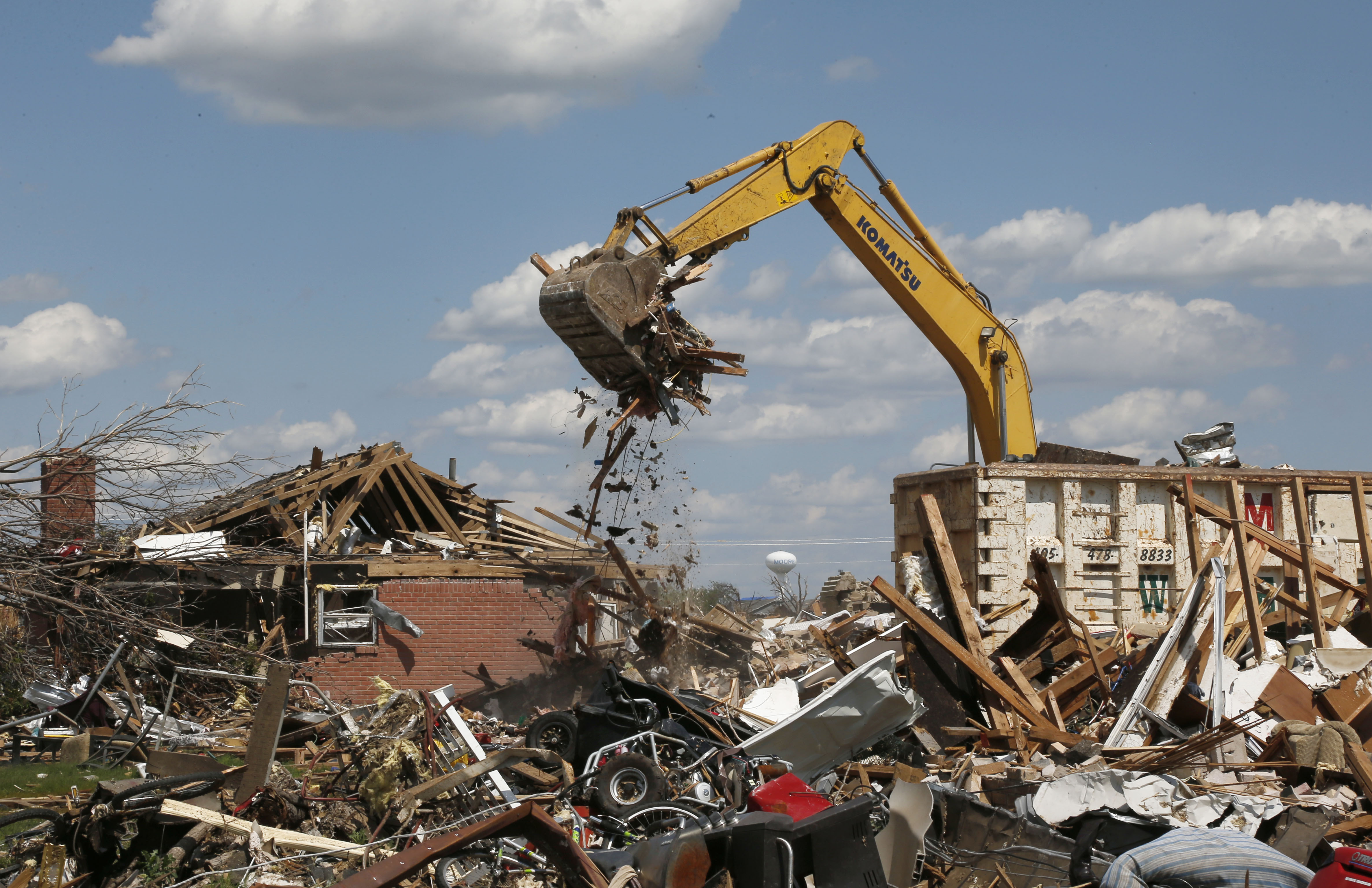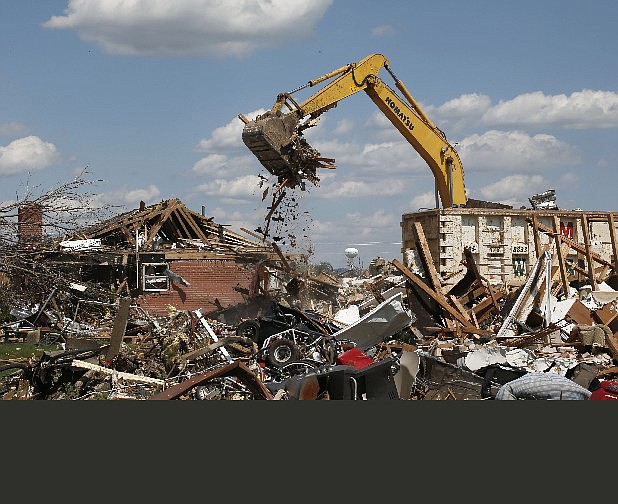 Heavy equipment removes debris from a home destroyed by the May 20 tornado in the Plaza Towers neighborhood of Moore, Okla. In 2013, in the nation's heartland, tornadoes are flirting with a record for the fewest, with just a bit more than half the normal number of nearly 1,300 twisters reported by mid-September. A shift in the jet stream is credited. Other damaging weather events have also eased.
Heavy equipment removes debris from a home destroyed by the May 20 tornado in the Plaza Towers neighborhood of Moore, Okla. In 2013, in the nation's heartland, tornadoes are flirting with a record for the fewest, with just a bit more than half the normal number of nearly 1,300 twisters reported by mid-September. A shift in the jet stream is credited. Other damaging weather events have also eased.WASHINGTON - After a couple of years of wild, deadly and costly weather, the United States is mostly getting a lucky break this year. So far.
Summer is almost over, and as of Tuesday morning, not a single hurricane had formed this year. Tornado activity in 2013 is also down around record low levels, while heat waves are fewer and milder than last year, according to the National Oceanic and Atmospheric Administration.
Meteorologists credit luck, shifts in the high-altitude jet stream, and African winds and dust.
"It's been great," said Deke Arndt, climate monitoring chief for NOAA's National Climatic Data Center in Asheville, N.C. "I hope that we ride this pattern out through this year and following years."
There have been eight tropical storms in the Atlantic. Not one has reached the 74 mph wind threshold to become a hurricane, though Tropical Storm Humberto off the coast of Africa is likely to become one soon.
If Humberto stays a tropical storm through 8 a.m. EDT Wednesday, it will be the latest date for the first hurricane of the season since satellites started watching the seas in 1967, according to the National Hurricane Center.
This year, overall storm activity in the Atlantic -- an index that combines number and strength -- is about one-fifth the average. That's despite warmer-than-normal seas, which usually fuel storms.
It has also been a record of nearly eight years since a major hurricane -- one with winds of 110 mph -- blew ashore in the United States. That was Hurricane Wilma, which hit Florida in October 2005.
Meteorologists say dry, stable and at times dusty air blowing from Africa is choking storms instead of allowing them to grow. On top of that, shifts in the jet stream -- the same river of air some blame for wild weather in 2011 and 2012 -- have caused dry air and wind shear, which interfere with storm formation, said Gerry Bell of NOAA's Climate Prediction Center.
Plain old random chance is also a big factor, said MIT meteorology professor Kerry Emanuel.
"Nobody's complaining," said former National Hurricane Center director Max Mayfield.
Bell and NOAA last month forecast a 70 percent chance of a busier-than-normal hurricane season, with six to nine hurricanes and 13 to 19 named storms. Bell said he is sticking with that forecast because it was just an unusually slow August, adding: "There's going to be more hurricanes; that's just a fact."
People shouldn't let their guard down because several past seasons have started off slow and ended quite busy and deadly -- 1967, 1984, 1988, 1994 and 2002, said Ryan Maue, a meteorologist with the private firm Weather Bell. Hurricane season starts in June and runs through the end of November
"All it takes is one bad hurricane to ruin an otherwise quiet hurricane season," said Weather Underground meteorology director Jeff Masters, a former hurricane hunter. "Recall that last year's worst storm -- Hurricane Sandy -- didn't occur until the third week of October."
In the nation's heartland this year, tornadoes are flirting with a record for the fewest, with just a bit more than half the normal number of nearly 1,300 twisters reported by mid-September. A shift in the jet stream is credited.
While the West has seen heat waves and major wildfires, the summer heat overall hasn't been nearly as oppressive and extensive as last year's record-setter. Last year, weather stations around the U.S. set more than 59,000 heat-related records through Sept. 9. This year they have set 21,254.
In 2011, the U.S. had 14 weather disasters that cost at least $1 billion. Last year it was 11. While NOAA hasn't counted them yet this year, the number is far lower, but includes two terrible Oklahoma tornadoes, meteorologists said.
National Weather Service Director Louis Uccellini said climate change tends to push the world toward more extreme weather, but sometimes natural variability pulls the weather more back to normal, and this is one of those years for much of the U.S. However, China, Japan and Korea have had many extremes, especially heat waves, Masters said.
And Uccellini had one big warning: "This year is not over yet."
